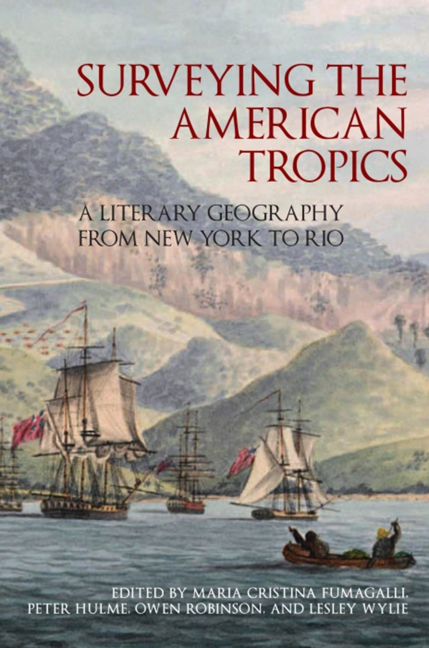Book contents
- Frontmatter
- Dedication
- Contents
- List of illustration
- Introduction
- A Tree Grows in Bajan Brooklyn: Writing Caribbean New York
- Reading the Novum World: The Literary Geography of Science Fiction in Junot Díaz's The Brief Wondrous Life of Oscar Wao
- Inventing Tropicality: Writing Fever, Writing Trauma in Leslie Marmon Silko's Almanac of the Dead and Gardens in the Dunes
- Imperial Archaeology: The American Isthmus as Contested Scientific Contact Zone
- Space Age Tropics
- Black Jacobins and New World Mediterraneans
- The Oloffson
- Dark Thresholds in Trinidad: Regarding the Colonial House
- Micronations of the Caribbean
- Golden Kings, Cocaine Lords, and the Madness of El Dorado: Guayana as Native and Colonial Imaginary
- Suriname Literary Geography: The Changing Same
- The Art of Observation: Race and Landscape in A Journey in Brazil
- Notes on Contributors and Editors
- Index
The Art of Observation: Race and Landscape in A Journey in Brazil
- Frontmatter
- Dedication
- Contents
- List of illustration
- Introduction
- A Tree Grows in Bajan Brooklyn: Writing Caribbean New York
- Reading the Novum World: The Literary Geography of Science Fiction in Junot Díaz's The Brief Wondrous Life of Oscar Wao
- Inventing Tropicality: Writing Fever, Writing Trauma in Leslie Marmon Silko's Almanac of the Dead and Gardens in the Dunes
- Imperial Archaeology: The American Isthmus as Contested Scientific Contact Zone
- Space Age Tropics
- Black Jacobins and New World Mediterraneans
- The Oloffson
- Dark Thresholds in Trinidad: Regarding the Colonial House
- Micronations of the Caribbean
- Golden Kings, Cocaine Lords, and the Madness of El Dorado: Guayana as Native and Colonial Imaginary
- Suriname Literary Geography: The Changing Same
- The Art of Observation: Race and Landscape in A Journey in Brazil
- Notes on Contributors and Editors
- Index
Summary
Tropical nature evokes a distinctive kind of geographical setting with its own characteristic flora and fauna. Its representation, however, has been varied, shaped by distinct perceptual frames and ideologies that in turn have produced an array of visual images and verbal accounts. During the early nineteenth century the study of nature was closely intertwined with science and religion. Alexander von Humboldt, the renowned Prussian naturalist and explorer who travelled extensively throughout Latin America, argued that the key to understanding the divinely-ordered natural world was through careful observation. He encouraged scientists and artists to travel and observe nature, especially in the tropics—the American tropics—where the exuberance of the natural world exceeded what the European eye knew. Humboldt offered a comforting mixture of rational science and firm belief in the existence of a world structure created by a supreme being that famed Harvard naturalist Louis Rodolphe Agassiz, in turn, advanced in the USA. However, in 1859, Charles Darwin's evolutionary theory produced a major change in the apprehension of the natural world, generating new lenses for observation. This essay contrasts three contemporary perspectives of a scientific expedition to Brazil that illustrate the ways in which this important shift reshaped the scientific and artistic representations of the tropics. Focusing on the travel narrative A Journey in Brazil (1868), co-authored by Agassiz and his wife Elizabeth Cary Agassiz, and the journal and letters of William James, psychologist and philosopher—at the time Agassiz's student—I argue that new evolutionary paradigms altered the concept of observation, complicating the ways in which nature and cultures were perceived. As Cary Agassiz and James negotiate the role of the viewer in observation, their descriptions of the tropics challenge Agassiz's ‘godlike’ explanations geared at providing certainty, signalling the epistemological shift introduced with the theory of evolution.
Considered the ‘founding father’ of the American scientific tradition, Swiss-born naturalist Agassiz revolutionised the study of natural science in the USA, both promoting and advancing its professionalisation. He was instrumental in the establishment of the American Association for the Advancement of Science, Harvard's Museum of Comparative Zoology, and the Lawrence School of Science.
- Type
- Chapter
- Information
- Surveying the American TropicsA Literary Geography from New York to Rio, pp. 313 - 345Publisher: Liverpool University PressPrint publication year: 2013



